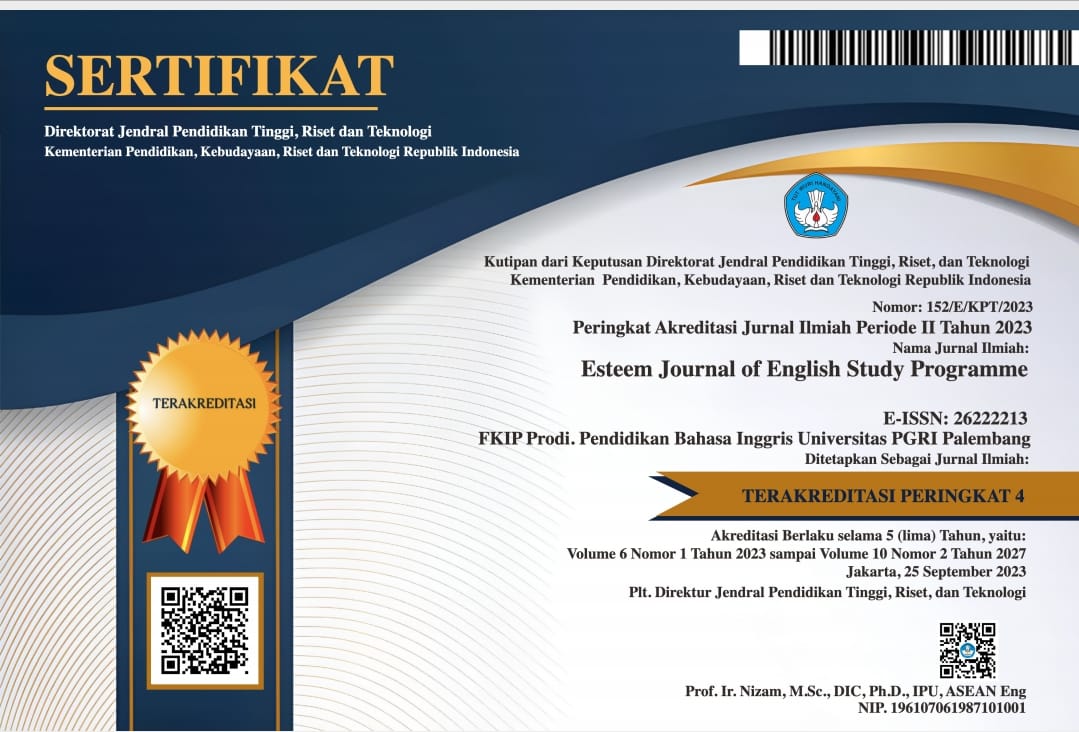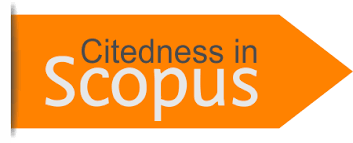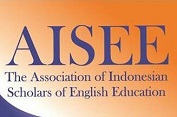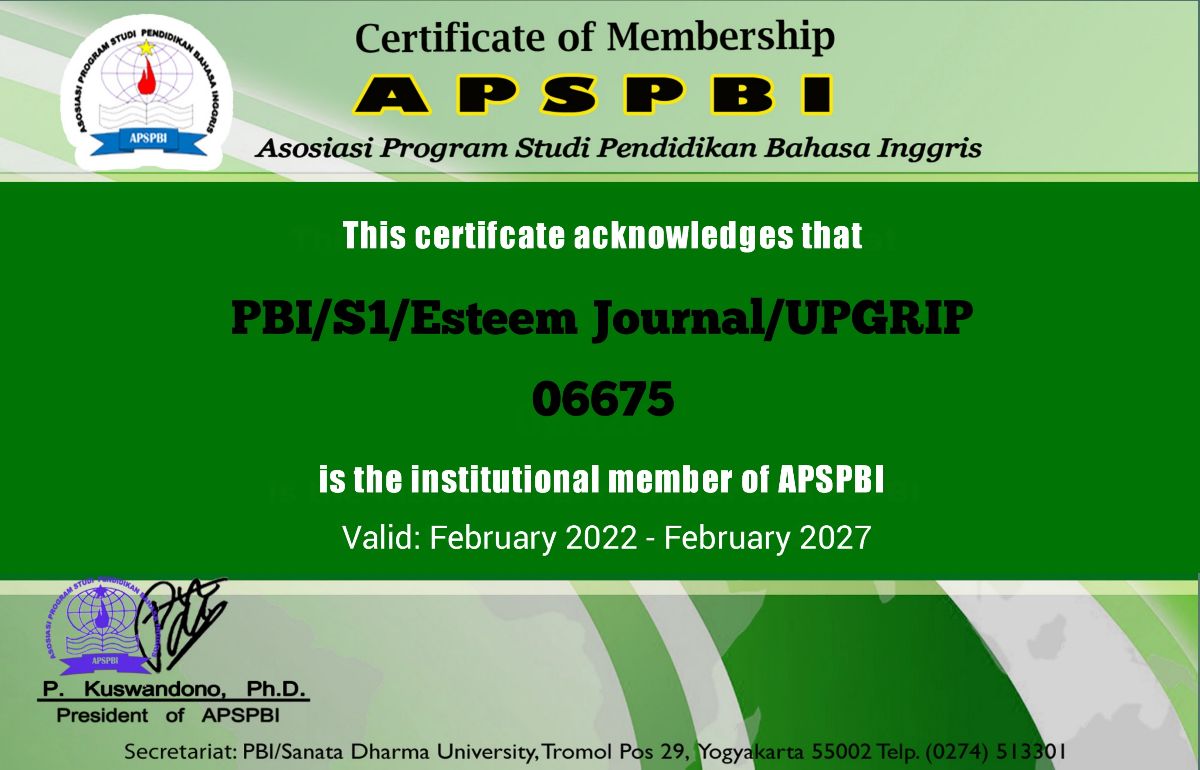FOSTERING THE STUDENTS’ SPEAKING ABILITY THROUGH COMMUNICATIVE APPROACH OF PARTICIPATION POINT SYSTEM
DOI:
https://doi.org/10.31851/esteem.v8i1.17804Keywords:
Fostering, Speaking Ability, Communicative Approach, Participation Point SystemAbstract
The objective of this study was to investigate how the implementation of a communicative participation point system could enhance students' speaking abilities. Specifically, the research aimed to determine whether the use of the participation point system influenced students' grades and how students perceived its role in developing their English-speaking skills. The study focused on both the learners' perceptions and their performance scores. A sample of 36 students was selected from a total of 150 12th-grade students at SMA Negeri 4 Palembang. Utilizing a mixed-method approach with an explanatory sequential design, quantitative and qualitative data were collected in two phases, with each phase informing the other. The findings revealed that the t-value (4.846) exceeded the t-table value (1.680), confirming that the alternative hypothesis (Ha) was valid. This indicates that the application of the communicative participation point system had a significant impact on students' speaking performance and scores.
References
Askhatova A. (2020). Pedagogical Sciences Importance of Vocabulary and Spoken Grammar in Teaching Spontaneous Speaking Skill. Sciences of Europe #, 49. https://cyberleninka.ru/article/n/importance-of-vocabulary-and-spoken-grammar-in-teaching-spontaneous-speaking-skill
Astuti, D. K. (2013). The gap between English competence & performance (Performance: The learners’ speaking ability). Indonesian Journal of English Education, 660-670.
Bashir, M., Azeem, M., & Dogar, A. H. (2011). Factor effecting students’ English speaking skill. British Journal of Arts and Social Science, 2(1).
Bess, M.,& Bess, D.A. (2002). A participation points system good for every tack. JALT 2002 Conference Proceedings. Japan Association of Language Teaching. https://www.researchgate.net/publication/281103092_The_use_of_a_participation_point_system_to_encourage_more_proactive_learner_participation_in_Japanese_university_English_classes
Cynthia, J., Nancy, W., & Steven, L. (1996). Ethical development, professional commitment and rule observance attitudes: A study of auditors in Taiwan. The International Journal of Accounting, 31(3), 365-379.
Creswell, J. (1994). Research design: Qualitative and quantitative approaches. SAGE Publications.
Creswell, J. W. (2012). Educational research (4th Ed.). Pearson Education.
Creswell, J. ., & Creswell, J. . (2017). Research Design: Qualitative, Quantitative, and Mixed Methods Approaches. Sage Publications.
Dzakiah, D., Assiddiq, M. A., & Mustari, S. H. (2020). Smartphone video recording as a learning tool to improve Indonesian EFL students speaking performance. Indonesian EFL Journal, 6(2), 157.
Fraenkel, J. R., Wallen, N. E., & Hyun, H. h. (2014). How To Design And Evaluate Research In Education (Eighth Edi). McGraw-Hill Education.
Gay, L.R. (1981). Educational research: Competencies for analysis and application. (2nd Ed). Charles E. Meril Publishing Company.
Gorsuch, G. J. (2011). Improving speaking fluency for international teaching assistants by increasing input. Journal English as a second language.4(4), 1-25.
Ghozali, I. (2016) Aplikasi Analisis Multivariete Dengan Program IBM SPSS 23. (8th Ed). Diponegoro University Publishing Agency.
Guo, R. X. (2013). The Use of Video Recordings as an Effective Tool to Improve Presentation Skills. Polyglossia, 24, 92-101.
Hadley, G. (2002). Encouraging oral communication in the EFL classroom. RELC. 33(2), 99-124.
Harris, J. (2016). Participation points to motivate high-achieving students. ASCD Express. 10(1).
Harmer, J. (2007).The practice of English language teaching (4th Ed.). Pearson Longman.
Heaton, J. B. (1988). Writing English Language Tests: Longman Handbook for Language Teachers (New Edition). Longman Group UK Ltd.
Herlina, H. & Marleni, M. (2019). Teaching listening comprehension by using interactive listening classroom performance. Esteem Journal of English Education Study Programme. 2(2), 1-25. http://doi.10.31851/esteem.v2i1.354
Herlina. H., Mortini, A. V., & Aprinati, R. (2020). The influence of whip around technique toward writing descriptive paragraph of the tenth grade students of state SMA Negeri 4 Palembang. Esteem Journal of English Education Study Programme. https://jurnal.univpgri-palembang.ac.id/index.php/esteem/article/download/4542/4272
Jaya, A. (2017). Sentence patterns of narrative text in English textbook in Indonesia. English Community Journal, 1(2), 69–74. https://jurnal.um-palembang.ac.id/englishcommunity/article/view/763
Jaya, A. Hermansyah, H., & Mortini, A. (2018). The Effect of Crawford Series Teaching (CST) on the Students’ Writing Achievement. ESTEEM: Journal of English Study Program, 1(1), 20-27. http://dx.doi.org/10.31851/esteem.v1i1.4827
Jeffrey, D. M. 2003. Participation points system to encourage classroom communication. The Internet TESL Journal, 9(8). http://iteslj.org/Techniques/Jeffrey-PointsSystem
Jumiati, A. A., & Asrina A. A. (2013). Improving the students’ speaking ability through participation point system (PPS) method. Exposure Journal, 2(2), 120-139. https://core.ac.uk/download/pdf/233602751.pdf
Khaidir., H. (2017). The use of grammar consciousness raising in teaching grammar. English Empower: Journal of Linguistics and Literature, 2(2), 64 – 70. http://ejournal.unitaspalembang.ac.id/index.php/eejll/article/view/29
Leonard, J. (2019). Beyond “(non) native-speakerism”: Being or becoming a native-speaker teacher of English. Applied Linguistics Review. https://doi.org/10.1515/applirev-2017-0033
Lynch & Andreson. (2012). Effective English learning: Unit 8. pronunciation. RLTC Self-study materials.
Marza, M. (2014). Pronunciation and comprehension of oral english in the english as a foreign language class: Key aspects, students’ perceptions, and proposals. Journal of Language Teaching and Research, 5(2), 262-273.
Phakiti, A. (2014). Experimental research methods in language learning. Bloomsbury Publishing Plc.
Rabbitt, T. (2015). Reading, writing, speaking, and listening? Which is most important and why?. http://www.tis.edu.mo/vision/reading-writing-speaking-and-listening-which-is-most-important-and-why/.
Raine, P. (2014). The use of a participation point system to encourage more proactive learner participation in Japanese University English classes. http://www.i-repository.net/contents/asia-u/11300140.pdf.
Rauf S. (2012). Improving the Students’ Reading Comprehension By Using Basal Reader Approach. (Sarjana’s Degree, University of Muhammadiah Makassar).https://digilibadmin.unismuh.ac.id/upload/27621-Full_Text.pdf
Richahrd, J.C & Willy, A.R. (2002). Methodology in language teaching an anthology of current practice. Cambridge University Press.
Sugiyono. (2019). Metode Penelitian Kuantitatif, Kualitatif Dan R&D (2 Ed.). (Sutopo, Ed.) Bandung: Alfabeta.
Tajizan, F. N., Ab Rahim, S., Abdul Halim, F. S., Abdullah, A., Ismail, I. N., & Cochrane, T.A. (2012). Implementing a Virtual Presentation Program in ESL Classrooms. International Journal of e-Education, e-Business, e-Management and e-Learning, 2(3), 1-5. https://ir.canterbury.ac.nz/items/a6c07349-c447-41c7-8eb0-97a2a3792b50
Theriana, A. (2018). Using an oblique technique to teaching translation of the Eleventh Grade Students of SMA Nurul Amal Palembang. Esteem: journal of English Programme. 1(1), 33-43. https://doi.org/10.31851/esteem.v1i1.4830
Theriana, A. 2019. Teaching reading comprehension through numbered heads together to the Eleventh Grade Students of SMA Nurul Amal Palembang. Esteem: journal of English Programme, 2(1), 18-24. https://doi.org/10.31851/esteem.v2i1.3474
Uzer, Y. V. (2019). The influence of context clues strategy on students’ reading achievement. Esteem: Journal of English Study Programme, 2(2), 154-159. https://doi.org/10.31851/esteem.v2i2.2457
Downloads
Published
Issue
Section
License
Copyright (c) 2025 Apriana, Lesi Anggraini

This work is licensed under a Creative Commons Attribution-NonCommercial-ShareAlike 4.0 International License.
Copyright Notice
Authors who publish with this journal agree to the following terms:
In order to assure the highest standards for published articles, a peer review policy is applied. In pursue of the compliance with academic standards, all parties involved in the publishing process (the authors, the editors and the editorial board and the reviewers) agree to meet the responsibilities stated below in accordance to the Journal publication ethics and malpractice statement.
Duties of Authors:
- The author(s) warrant that the submitted article is an original work, which has not been previously published, and that they have obtained an agreement from any co-author(s) prior to the manuscript’s submission;
- The author(s) should not submit articles describing essentially the same research to more than one journal;
- The authors(s) make certain that the manuscript meets the terms of the Manuscript Submission Guideline regarding appropriate academic citation and that no copyright infringement occurs;
- The authors(s) should inform the editors about any conflict of interests and report any errors they subsequently, discover in their manuscript.
Duties of Editors and the Editorial Board:
- The editors, together with the editorial board, are responsible for deciding upon the publication or rejection of the submitted manuscripts based only on their originality, significance, and relevance to the domains of the journal;
- The editors evaluate the manuscripts compliance with academic criteria, the domains of the journal and the guidelines;
- The editors must at all times respect the confidentiality of any information pertaining to the submitted manuscripts;
- The editors assign the review of each manuscript to two reviewers chosen according to their domains of expertise. The editors must take into account any conflict of interest reported by the authors and the reviewers.
- The editors must ensure that the comments and recommendations of the reviewers are sent to the author(s) in due time and that the manuscripts are returned to the editors, who take the final decision to publish them or not.
Authors are permitted and encouraged to post online a pre-publication manuscript (but not the Publisher final formatted PDF version of the Work) in institutional repositories or on their Websites prior to and during the submission process, as it can lead to productive exchanges, as well as earlier and greater citation of published work (see The Effect of Open Access). Any such posting made before acceptance and publication of the Work shall be updated upon publication to include a reference to the Publisher-assigned DOI (Digital Object Identifier) and a link to the online abstract for the final published Work in the Journal.





























